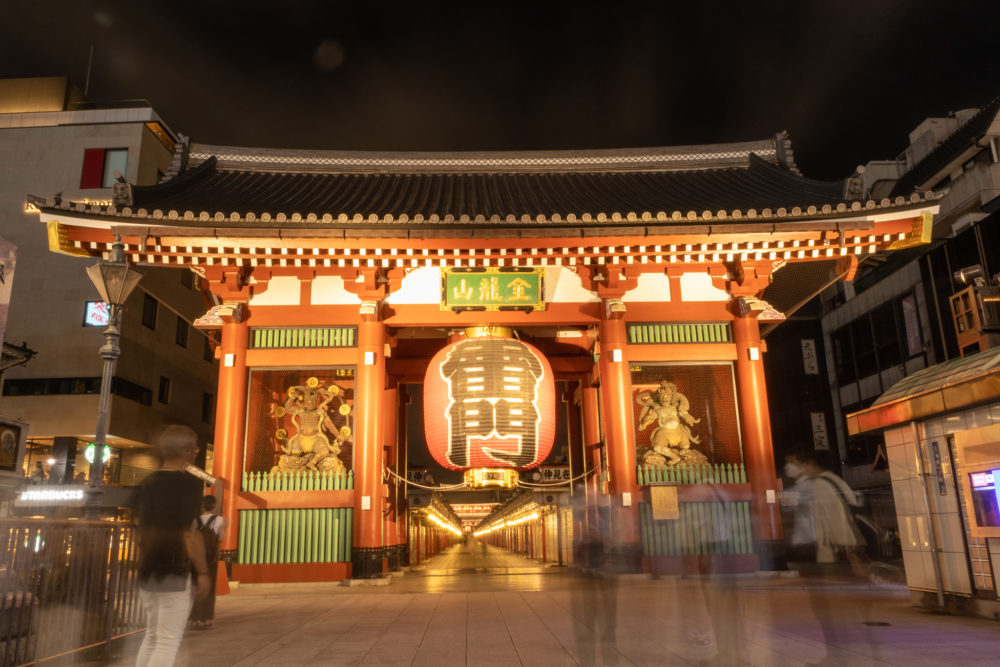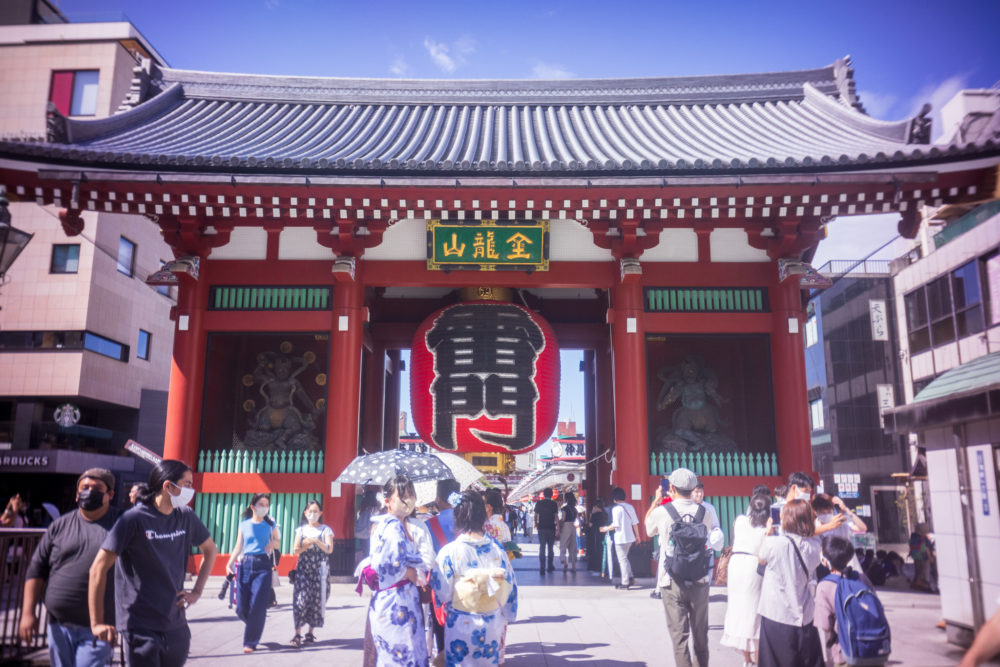Tokyo Shitamachi Guide’s “Highlights” category covers must-visit spots in Tokyo’s Shitamachi area (the area along and east of the Sumida River). We select an interesting spot each time for your sightseeing in Tokyo.
This time, our recommended spot is Kaminarimon Gate at Sensoji Temple in Taito Ward.
Kaminarimon Gate (the Gate of Thunder) is the first main gate of Sensoji Temple. When you hear the words “Asakusa” or “Sensoji Temple,” you might think of this gate. This gate is a popular photo spot; it’s always full of tourists during the day.
The official name of this gate is Furaijinmon Gate (the Gate of Fujin and Raijin). This gate enshrines Fujin (the Wind God) on the right and Raijin (the Thunder God) on the left. Both Fujin and Raijin are guardians of Buddhist world.
This blog post will share information about Kaminarimon Gate at Sensoji Temple. Please use it as a reference when you visit Tokyo’s Shitamachi area, especially the Asakusa area, for sightseeing.
We hope this blog post will help you somewhat when you visit Tokyo for sightseeing. If you have any questions, feel free to contact us through the contact form.
This blog post is also available in Japanese. You can refer to it at the following link:
History
According to Sensoji Temple, it is unknown when exactly Kaminarimon Gate was built. But its history is said to date back to the 10th century. And its history is related to a military commander who played an active role in the Taira no Masakado Rebellion.
In 935, the Taira no Masakado Rebellion broke out. Taira no Masakado, a local ruling family in the Kanto region, rebelled against the central government in Kyoto. He tried to establish an independent nation by occupying most of the Kanto region.
In 940, the central government in Kyoto suppressed the rebellion. And Taira no Kimimasa was one of the military commanders who contributed to the suppression. He was a cousin of Taira no Masakado.
In the same year, Taira no Kimimasa was appointed the chief governor of the Awa-no-Kuni Province for his contributions. The Awa-no-Kuni Province is the southern part of present-day Chiba Prefecture.
But Taira no Kimimasa was not happy with it. He wanted to become the chief governor of the Musashi-no-Kuni Providence, which is present-day Tokyo, Saitama Prefecture, and part of Kanagawa Prefecture.
In 941, Taira no Kimimasa prayed for his promotion at Sensoji Temple. In 942, he successfully became the chief governor of the Musashi-no-Kuni Providence. So he thanked Sensoji Temple very much.
At that time, Sensoji Temple was in ruins due to the Taira no Masakado Rebellion. Taira no Kmimasa devoted his efforts to rebuilding the temple. It was around this time that Taira no Kimimasa built Kaminarimon Gate.
Kaminarimon Gate has been burned down and rebuilt repeatedly. Matsushita Konosuke built the current gate in 1960. He was the founder of Panasonic.
Highlights
A Gigantic Paper Lantern

One of the highlights of Hozomon Gate is the gigantic paper lantern saying “Kaminarimon.”
According to Wikipedia, the history of the lanterns at Kaminarimon dates back to 1795. Craftsmen who built the roof of the gate dedicated the paper lantern to Sensoji Temple.
When Matsushita Konosuke built the gate in 1960, he also dedicated the current design of the lantern (the design saying “Kaminarimon”) to the temple.
Fujin and Raijin
The official name of this gate is Furaijinmon Gate (the Gate of Fujin and Raijin). This gate enshrines Fujin (the Wind God) on the right and Raijin (the Thunder God) on the left. Both Fujin and Raijin live in Tenbu of the Buddhist world.
According to Buddhism, it categorizes Buddhist deities into four classes: Nyorai, Bosatsu, Myoo, and Tenbu. Tenbu is the fourth class from the top. Deities who have converted to Buddhism from other religions live in Tenbu.
Originally, Fujin and Raijin were demons who annoyed people. But the deities of Tenbu exterminated them. As a result, both Fujin and Raijin converted to Buddhism and became Buddhist deities who live in Tenbu.
As mentioned earlier, Fujin is the Wind God, and Raijin is the Thunder God. Both are associated with wind and rain. According to Sensoji Temple, there are two major reasons why the temple enshrines these two gods:
- to protect Sensoji Temple from water and storm disasters;
- to bring a bountiful harvest to the neighborhood by controlling wind and rain.
Tenryu and Kinryu
Sensoji Temple enshrines Tenryu (the Heavenly Dragon God) and Kinryu (the Gold Dragon God) behind Kaminarimon Gate. Tenryu protects the Buddha’s world, and Kinryu protects our world. And both are the Water Gods.
Tenryu and Kinryu are both deities in Tenbu. The major role of the deities who live in Tenbu is to protect the Buddhist deities, Buddhism (Buddha’s teachings), and the Buddhist world. In addition, they also bring people various divine benefits.
As Sensoji Temple’s official name, “Kinryuzan (the mountain of Kinryu) Sensoji,” suggests, this temple has deep associations with dragons. Sensoji Temple claims that Tenryu and Kinryu are the guardian gods of the temple.






